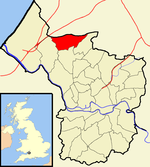Henbury railway station
Beeching closures in EnglandDisused railway stations in Bristol, Bath and South GloucestershireFormer Great Western Railway stationsHenburyPages with no open date in Infobox station ... and 6 more
Proposed railway stations in EnglandRailway stations in Great Britain closed in 1915Railway stations in Great Britain closed in 1965Railway stations in Great Britain opened in 1910Railway stations in Great Britain opened in 1922Use British English from March 2018

Henbury railway station served the Bristol suburb of Henbury, England, from 1910 to 1965. The station was situated on the Henbury Loop Line of the Great Western Railway and was opened on 9 May 1910 for passenger services. Under the Beeching cuts, it was closed to passengers on 23 November 1964, with goods services ceasing on 5 July 1965. There is a proposal to reopen the station as part of the Greater Bristol Metro scheme.
Excerpt from the Wikipedia article Henbury railway station (License: CC BY-SA 3.0, Authors, Images).Henbury railway station
Station Road,
Geographical coordinates (GPS) Address External links Nearby Places Show on map
Geographical coordinates (GPS)
| Latitude | Longitude |
|---|---|
| N 51.515 ° | E -2.6251 ° |
Address
Henbury
Station Road
BS10 7TA , Almondsbury
England, United Kingdom
Open on Google Maps






